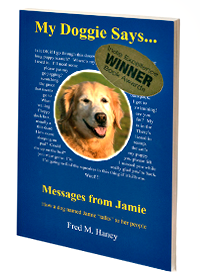If you’ve ever lost a dog, or any pet that was truly part of your family, you know there’s a grieving time. A time when it would be unthinkable to bring another dog into your family. Barbara and I knew there would be such a time, but we didn’t know how long it would last.
The first few days after Jamie (the hero of My Doggie Says…: Messages from Jamie. How a dog named Jamie “talks” to her people.) left us were especially difficult. Her toys were still scattered around the house, right where she left them. We would walk past her food and water dishes and expect to see her eating and drinking. For the first time in years, she wasn’t with us on our morning jog. We would wake up in the morning and expect her to be beside our bed, ready to say a doggie “good morning.” And so it was through the 2006 Christmas Holiday season and into January and February of 2007.
Sometime in February, Barbara started poking around on the Internet, and she came home one day and said, “I found a litter of nine Golden Retriever puppies, and they’re about four weeks old.” The puppies were at Woodland Golden Retrievers, and it would be about four weeks before they could leave their mother. We both felt that the time was right to think about a new dog.
For the next four weeks, we spent our Saturday mornings getting to know the puppies — especially the four females, who were marked with a little dab of fingernail polish on the back of their heads. (The males’ marks were on their butts.) There was Miss Red, Miss Pink, Miss Orange and Miss Green. All just as sweet as could be, but Miss Green was clearly the runt. On our first visit, she was quite small and quiet. She avoided the puppy play, and kept pretty much to herself. The superstars our first two visits were Miss Pink and Miss Red, both of whom were playful and full of energy. Miss Pink was especially friendly with us. She would be the first to run to us, and she seemed to enjoy chewing on my shoe laces.
But the next two weeks, Miss Green came on strong. She grew so fast she almost caught up with the other puppies. And she became the most energetic and playful of the bunch. All of the puppies had beautiful Golden Retriever lines, but Miss Green seemed to have a special look about her. When it was time to decide, the breeder concluded that Miss Green would be a good fit for our family. We were delighted, because she was our choice at that point, and Miss Green became Woodlands Callaway Hole-in-One, or Callie for short.
“Another spirit, another life, another joy.” These words of Dr. Omoto were with us during all of our puppy visits. We had to keep reminding ourselves, “This dog won’t be another Jamie. It will be different. We need to find out who this new dog is and nurture her in every way possible, and never expect her to be another Jamie.”
It was almost as if Callie had heard Dr. Omoto. She did something on her very first day at our house that made it clear that she was her own dog. In our back yard, there was an under-inflated soccer ball. One of Callie’s first acts at our house was to run to the other side of the soccer ball and “challenge” me to a soccer game. This photo was taken a few weeks later, but it’s exactly what she did on day one.

In a future blog, I’ll try to download some video of Callie playing soccer. She really plays “keep-away,” and it’s her own invention. No one taught her to do it. She traps the ball under her tummy, or between her head and her front paws. It’s my job to extract the ball and give it a kick, so Callie can run and trap it again.
Callie is just about five months old now, but she’s defined herself in some ways that are quite different from Jamie. Jamie was absolutely not a “ball-dog.” She just didn’t care about balls, except for one very special toy. But Callie loves balls — soccer balls, golf balls, tennis balls and any other ball she sees. Unlike Jamie, Callie is a great jumper. (Not surprising, her father, Cutter, is an American and Canadian Grand Champion in Agility Training.) Callie loves to leap over the golf-cart barriers on the golf course near our house. Like Jamie, Callie is very outgoing and friendly with people. But, unlike Jamie, she is extremely social and friendly with other dogs. She runs to visit with other dogs, and we’re having to learn some new habits to accomodate her doggie-social instincts.
The Doggie is the Message. You have to understand your dog’s breeding and instincts in order to understand and nurture its personality. Every dog is different. Another spirit, another life, another joy.












